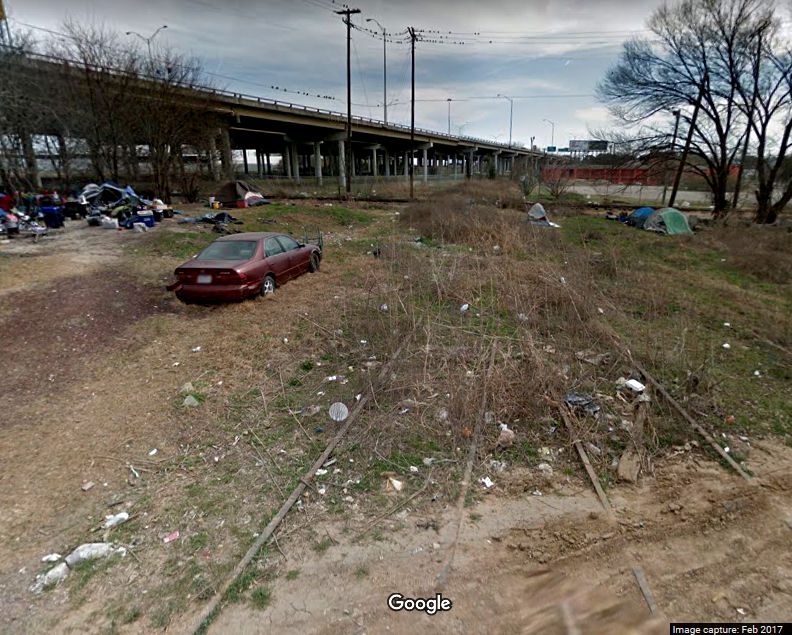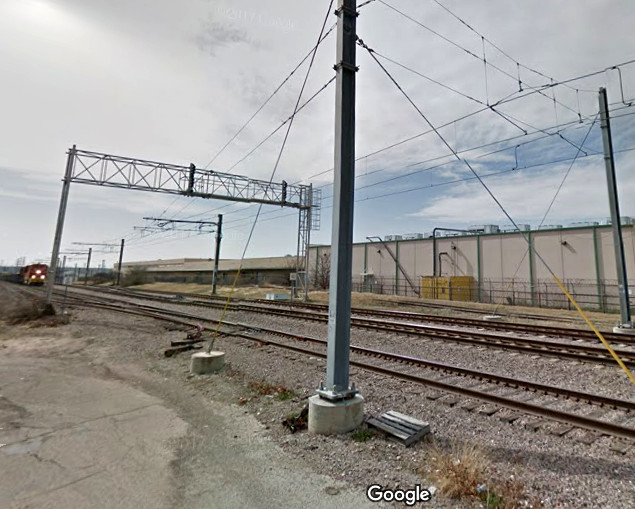Texas Railroad History - Tower
10 - Dallas
A Crossing of the Gulf, Colorado & Santa Fe Railway and the
Houston & Texas Central Railway
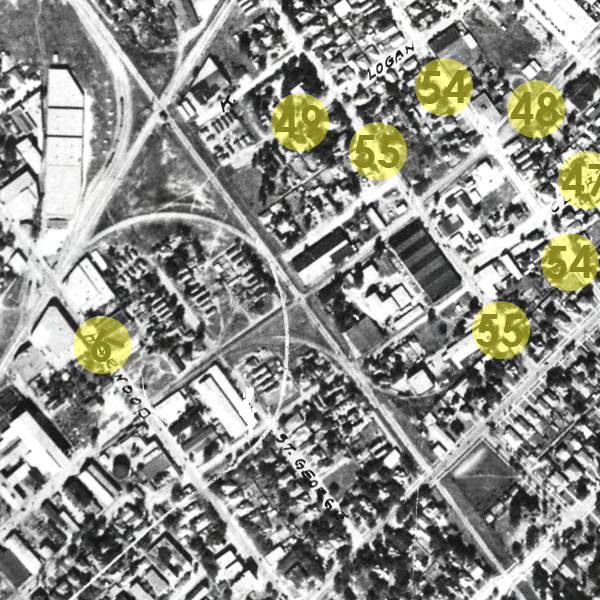

Above
Left: In October 1930, Sherman Mills Fairchild
took 93 aerial photographs of Dallas and surrounding areas commissioned by the
City of Dallas that are now available on-line
from Southern Methodist University. This Fairchild image shows the Houston &
Texas Central (H&TC) running diagonally across the image from upper left to
lower right. The Tower 10 crossing, where the Gulf, Colorado & Santa Fe (GC&SF)
Railway crossed the H&TC, is at upper left. Visible near the center is where the
Dallas Terminal Railway crossed the H&TC, a junction also
controlled by Tower 10. Numerous exchange tracks among the railroads are also
visible. Above Right:
Magnification of the image shows Tower 10 located due south of the diamond,
casting a black shadow to the north. (hat tip, Dennis Hogan.)
Below: This snippet from a
larger 1915 track chart of Dallas (courtesy, Ed Chambers) prepared by the Missouri-Kansas-Texas (MKT) Railroad
Engineering Department has
been annotated to show the locations of Tower 10 and
Tower 19. Santa Fe designed and constructed both towers, which were less
than a mile apart. Tower 10's functions were eventually consolidated into Tower
19.
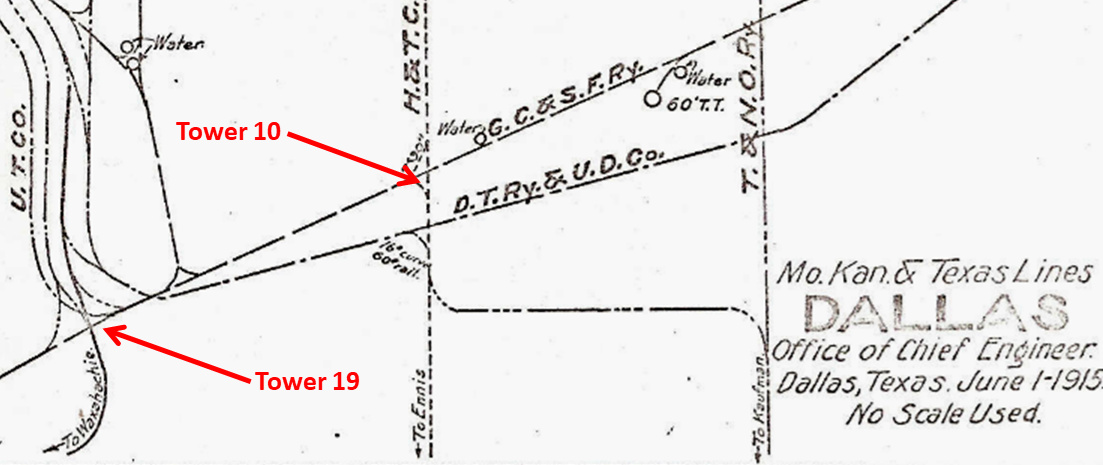
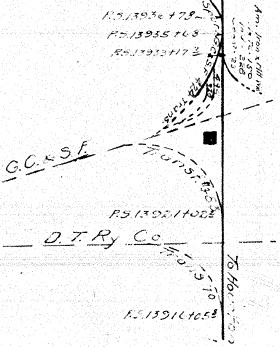 |
Left: This
snippet from a 1926 track chart from the
T&NO Archives (courtesy,
Carl Codney) shows the location of Tower 10 in the southwest corner of
the diamond as a black square. It also shows that there was a transfer
track between the Santa Fe and H&TC main lines that ran behind the
tower. The 1938 edition of the same track chart eliminates the tower
icon. By that date, Tower 10's functions had been consolidated into
Tower 19 (but whether the tower structure still stood is unknown.) |
The Houston & Texas Central (H&TC) Railway entered
Dallas from the south in 1872, the first railroad into this future metropolis.
By 1883, the H&TC had come under Southern Pacific (SP) control; it was eventually leased by (1927) and
then merged into (1934) the Texas & New Orleans Railroad, SP's primary operating
company for Texas and Louisiana lines. In 1880, the Dallas,
Cleburne & Rio Grande Railroad completed a narrow gauge railroad between Dallas
and Cleburne that crossed the H&TC, but the new line was immediately abandoned
upon completion. The assets were then acquired by the newly chartered Chicago,
Texas and Mexican Central Railway which planned to convert it to standard gauge.
The conversion was not actually accomplished until after the Gulf, Colorado &
Santa Fe (GC&SF) Railway acquired the line in 1882. Four years later, the
GC&SF was sold to the Atchison, Topeka and Santa Fe Railway which had
operations from the midwest to the west coast. GC&SF became Santa Fe's primary
operating company in Texas into which various other Santa Fe acquisitions in
central, east and north Texas were
merged (west Texas lines were consolidated under the
Panhandle & Santa Fe Railway.) The GC&SF remained a subsidiary until 1965 when it was formally
merged into Santa Fe.
On June 24, 1903, Tower 10 became the first numbered
electric interlocking in
Texas (all prior interlockers were manual),
protecting the crossing of the H&TC and GC&SF in south Dallas. The
interlocking plant had 12 levers and 12 functions, built by Taylor Signal Co. On July 23, 1932, a proposal was
submitted by GC&SF to combine Tower 10 with nearby Tower 19
(which was also an electric interlocker.) On September 28, 1932, a letter was
sent by the Railroad Commission of Texas (RCT) Engineering Dept. to the
Commissioners recommending approval. RCT's Tower 19 file archived at DeGolyer
Library, Southern Methodist University, contains references to
"Interlocker10-19", but this may have been shorthand notation for the
fact that both interlockers were controlled from that location, not that they
were functionally integrated into a combined plant. There is also a 1961
reference to "Interlockers No. 10 and 22"
(Tower 22 being a mechanical interlocker where the
Texas & Pacific crossed the
GC&SF further northeast), implying that the Tower 10 interlocking
plant was still separately identified at that late date. The significance of the
1944 date listed for retirement of Tower 10 is unknown, perhaps representing a demolition date for the structure,
which could have been used to house electronics or other materials storage after manned operations
ceased.
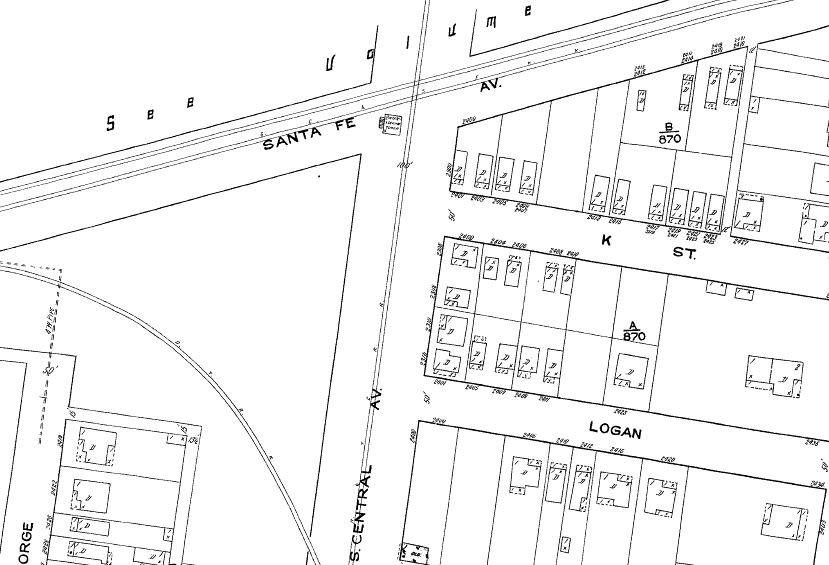
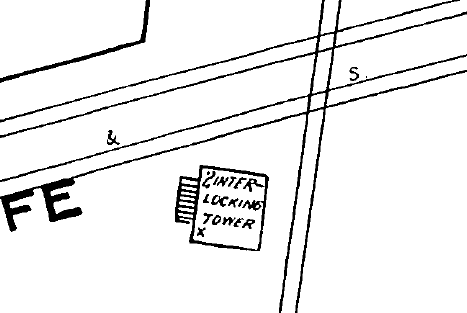
Above Left: The location of Tower 10,
on the south side of the diamond, is illustrated on the 1922 Sanborn Fire
Insurance map of Dallas. Above Right:
Magnification of the map shows that the "Interlocking
Tower" was
a 2-story structure with an outer staircase on the west side of the
building.
Location Map, Tower 10
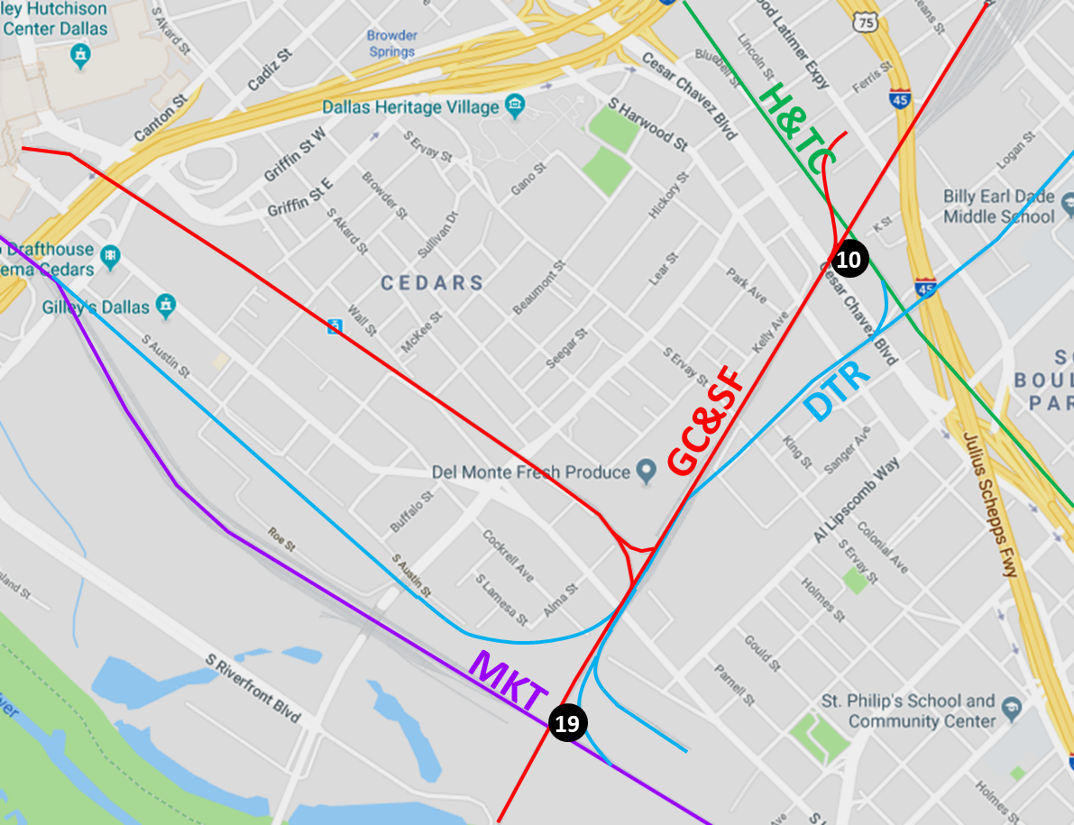
Above: This annotated map
shows the general heritage of the rail lines involved with Tower 10 and Tower 19
south of downtown Dallas. In addition to SP and Santa Fe, the Dallas Terminal
Railroad and Union Depot Co. (DTR) and the Missouri-Kansas-Texas (MKT) Railroad also had tracks
operating in this vicinity. Although solid lines are used, some of these tracks
are no longer in service. The mass of tracks adjacent to the GC&SF line east of I-45 was formerly the Santa Fe yard and is now the main rail yard for Dallas
Area Rapid Transit (DART).
Below: This 2009 aerial image facing north shows the Tower 10
crossing. The remnants of the original
H&TC route
are now used as
industrial tracks. The exchange track serves a scrap metal
facility. The double track is the
DART light rail line that
leads to their yard
located just beyond the freeway. DART acquired this portion of the Santa Fe
right-of-way for its initial construction of light rail in south Dallas. The
Sanborn map shows this was also a double track in 1922. A short distance south
of Tower 10, a
diamond
remains in place where the DTR and the H&TC crossed.
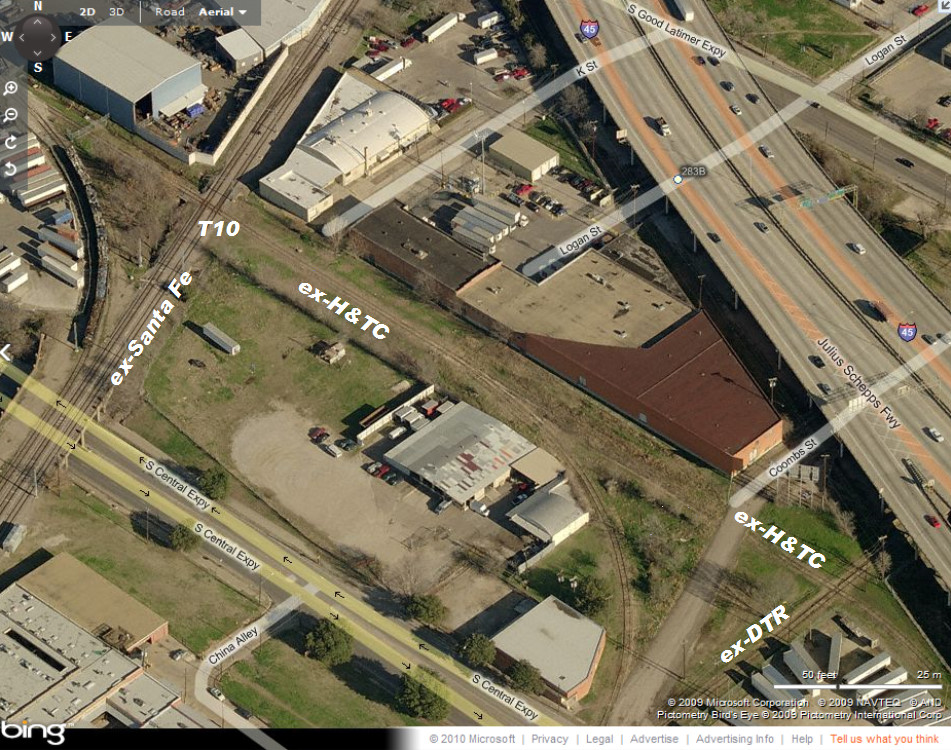
Observations by Frank
Fertitta
Before DART came along, I used to go down to that part of town
to watch SP switch the Austin Steel
plant and some of the
machine shops along Coombs St as well as checking out the Santa
Fe operations
at their yard east of this [Tower 10] location. The SP switcher
came out of Miller yard past Belt Junction to the
northwest toward
Tower 19 and just before it got to the tower it would take the
switch to the right
that put it on a track parallel to the Santa
Fe. Once past the backside of Austin Steel it took the
crossover
to get to the north side of the Santa Fe tracks and turned to
the north on an interchange
track onto the original H&TC line
behind that scrap metal yard and then back across the diamond
to
the south to get to the industries along Coombs St. These industries
were originally accessed from
the west across SP's own bridge
across S. Ervay, but that bridge was torn out some time around
1954,
necessitating these movements.
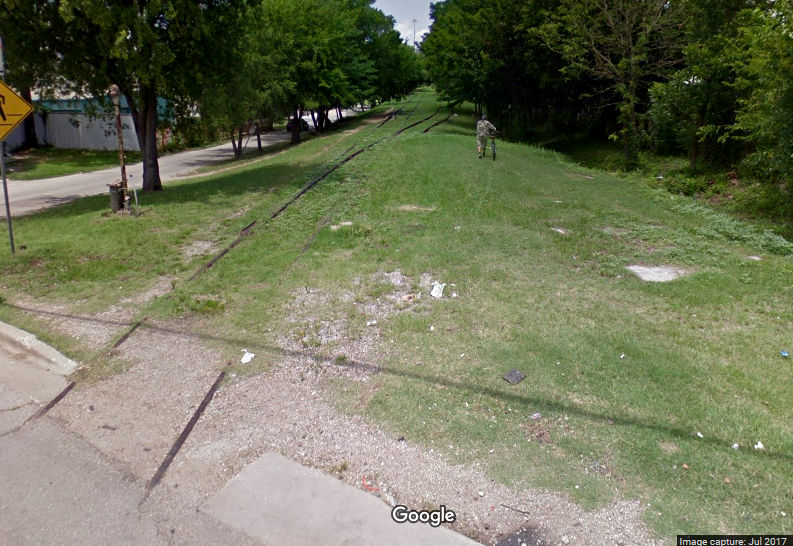
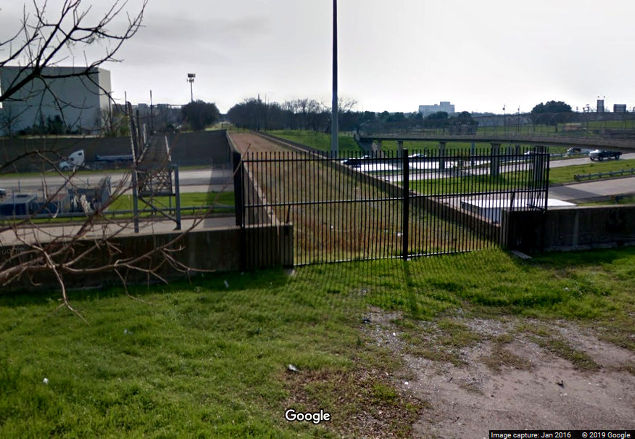
Above Left: Rails remain on the former H&TC main line
right-of-way looking north from Hickory St. This section evolved into an
industrial track over the decades, but has been out of service for many years.
Above Right: Further north,
the H&TC bridge over I-30 on the south edge of downtown Dallas remains intact as
of January, 2016. This view faces south from the north side of I-30.
Below Left:
Looking south from Coombs St. along the original H&TC main line right-of-way,
the former DTR tracks are visible ahead. They still cross on an east/west
heading, but are no longer in service. This is where southbound DTR switchers would turn to work the
"industries along Coombs St." described by Frank Fertita.
Below Right: The "crossover"
Frank mentioned is still intact to allow freight switching despite the
construction of DART along the Santa Fe right-of-way. Here, a switcher is eastbound on the south track
paralleling the DART tracks. Shortly after passing the camera location, it will
cross over to the north side of the DART tracks, allowing it to turn north at
Tower 10 to access the industrial track that was formerly the H&TC main line. In
reference to the annotated location map above, the crossover is adjacent to the
"Kelly Ave." label. (Google Street View images)
